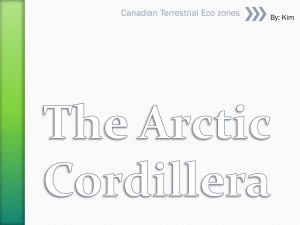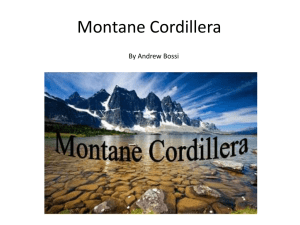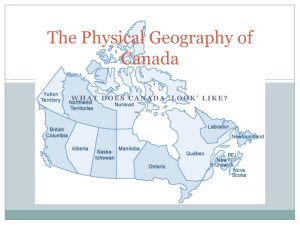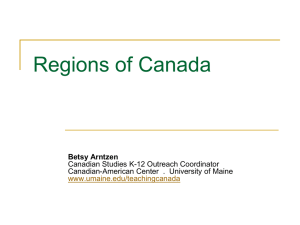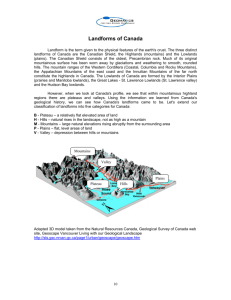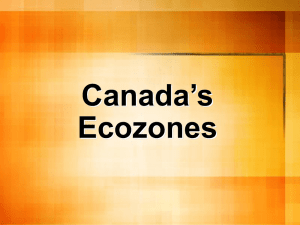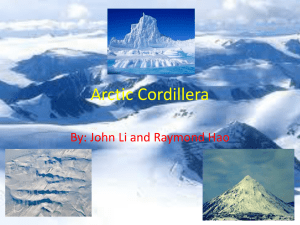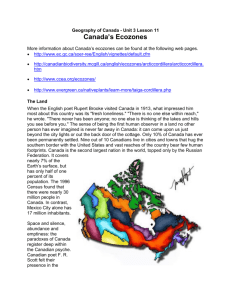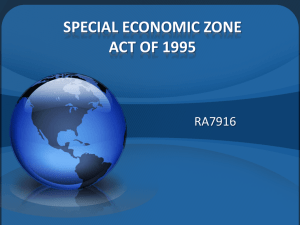Canada`s Ecozones
advertisement
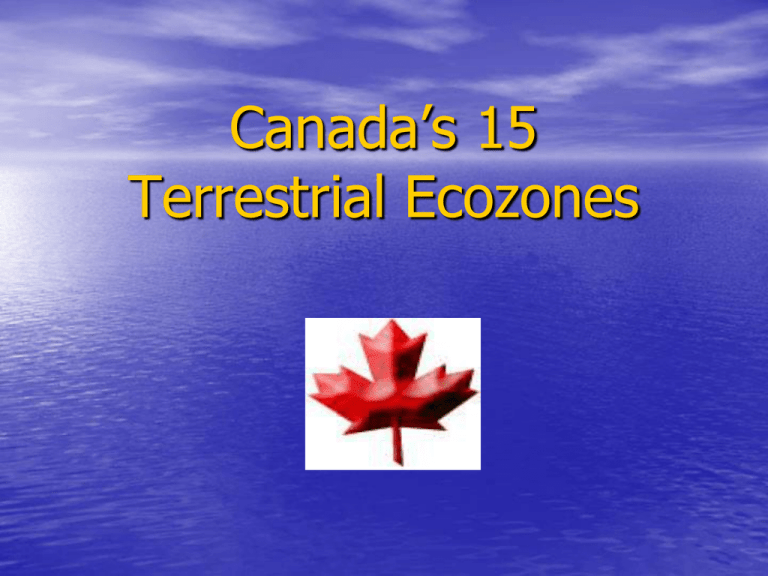
Canada’s 15 Terrestrial Ecozones What is an Ecozone? • It is a geographic zone that can be defined by similar characteristics • The characteristics can include: landforms, climate, soils, vegetation, wildlife, and human activity • Canada has 15 ecozones Arctic Cordillera Bylot Island Pond Inlet, Baffin Island Ice Tongue, Ellesmere Island Arctic Cordillera • Northern Nunavut, including sections of Baffin Island and Ellesmere Island • Most inhospitable ecozone • Little to no vegetation • About 1,000 permanent residents, mostly Inuit • Too harsh for reptiles, amphibians or insects Arctic Wolf Snowy Owl Walrus Northern Arctic Polar Bear Pass, Bathurst Island Arctic Landscape during summer months Barren Land Caribou Snow Goose Northern Arctic • Northern Nunavut and NWT • Coldest and driest ecozone • There is total permafrost, and this can extend to over 1km in thickness • Little vegetation Southern Arctic Wetlands, Yukon Polar Bear Arctic Hare Southern Arctic • Northern edge of continental NWT and northern Quebec • Landscape formed through glaciation • The tree line is at the very south edge of this ecozone • Population is around 10,000 Beaver pond in Northern Alberta Taiga Plain Keg River, Alberta Western Toad (found only in BC and the Yukon Moose Taiga Plain • Centred around the Mackenzie River • Population is around 22,000, with most people making their income off the land – mining, forestry, etc. Taiga Shield Osprey American Marten Lynx Taiga Shield • Stretches eastward from NWT to Quebec • Part of the Canadian Shield, which has some of the world’s oldest rock deposits • Landforms include: wetlands, shrub lands and forests Boreal Shield Saguenay Fjord, Quebec Lower Laurentians, Quebec Shawbridge, Quebec Boreal Shield • Largest ecozone in Canada (reaches across Alberta, Saskatchewan, Manitoba, Ontario, Quebec and Newfoundland • Glaciers responsible for wetlands, lakes in the area • Many diverse landscapes Beaver Great Blue Heron Eastern Red Cedar American Black Bear Atlantic Maritime Harbour Seal (top and left) Gooseberry Bay, Nova Scotia Atlantic Maritime • Comprises the Maritime provinces • Very high precipitation rates – this area is home to the most storms in all of Canada • New Brunswick is densely forested, and that industry is very large in this ecozone, in addition to fisheries Mixedwood Plains Niagara Falls, Ontario Groundhog Killdeer Raccoon Mixedwood Plains • Southern Ontario and Quebec • Most heavily populated ecozone • Major land use is agriculture • Smallest ecozone • Highly changeable weather patterns Buffalo Jump Prov. Park, Alberta Boreal Plain Alberta landscape American Badger Great Horned Owl Boreal Plain • Population around 750,000 scattered in small communities • Canada’s oil and gas industry • Located in the central to northern sections of the Prairie Provinces • Rocky Mountains create rainshadow effect Alberta Hay Field Prairie Plain Canola Field Long-tailed Weasel The Bad Lands Prairie Plain • Southern Alberta, Saskatchewan and Manitoba • Major land use is agriculture • 80 per cent of the population resides in cities • Glaciers formed landscape – the “Bread Basket” created when an inland lake dried up leaving fertile land Taiga Cordillera Mountain Goat Gyrfalcon American Pika Taiga Cordillera • The border between Yukon and NWT • This area represents the most northern section of the Rocky Mountains • Landforms consist of mountains and valleys Boreal Cordillera Kluane Lake, Yukon Glacier in Yukon Kaskawalsh Glacier, Kluane Boreal Cordillera • Southern Yukon and northern British Columbia • Mining is a primary industry (Klondike Gold Rush) • Landforms include: mountains, plateaus and valleys Kluane Lake, Yukon Arctic Ground Squirrel Whitebark Pine Pacific Maritime Mountain Lion (Cougar) California Sea Lion BC Rainforest Salmon Glacier, BC Pacific Maritime • Comprises BC’s west coast • This ecozone has the wettest weather and tallest trees in Canada • Climate is dictated by Pacific Ocean • There are still glaciers found in high elevations Montane Cordillera Burstall Pass Helmcken Falls (Wells Gray National Park, BC) Jasper Provicial Park California Big Horn Sheep Wolverine Montane Cordillera • Southern BC and western Alberta • The most diverse ecozone because of its 2 mountain ranges • Susceptible to orographic (relief) precipitation • Many national parks (e.g., Banff, Jasper) Hudson Plains Bearded Seal Balsam Poplar American Mink Hudson Plains • Area surrounding Hudson Bay • This area represents the largest system of natural wetlands in the world • Large vegetation (trees) found only at higher and drier elevations Source: Canadian Biodiversity Website. (2012). Retrieved from: http://canadianbiodiversity.mcgill.ca/english /index.htm
